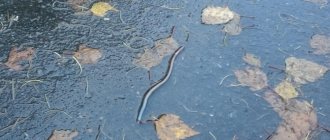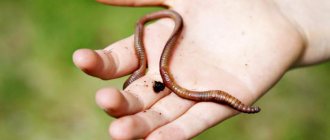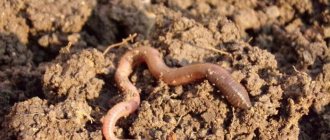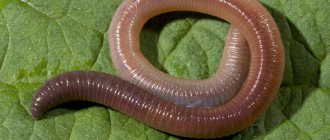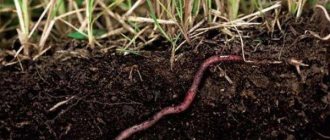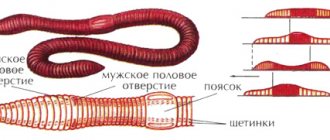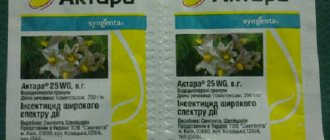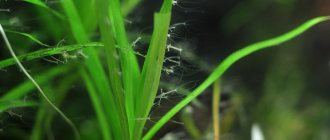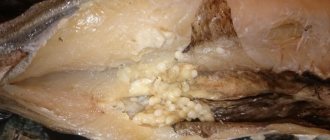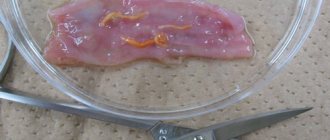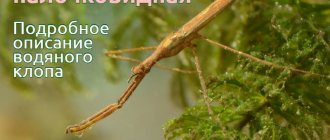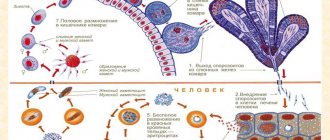In previous articles in the series “Stop destroying the soil by digging and weeding”, “Plane cutter instead of cultivator”, “Biological protection from pests and weeds”, “Intensive planting”, we found out that the main enemies of fertility are deep cultivation of the soil and the thoughtless use of pesticides. This leads to the destruction of the main producers of humus, earthworms. Today we will talk about how to help increase the number of worms in the garden, as well as how to organize a worm barn - a place for raising these useful animals, which are the only producers of the most valuable fertilizer - vermicompost.
Charles Darwin also wrote in his writings that earthworms in the process of life activity have a positive effect on the structure and fertility of soils: “Worms excellently prepare the soil for plant growth... They sift the soil so much that no dense mineral particles remain in it... They thoroughly mix everything soil, like a gardener preparing crushed earth for his most exquisite plants.”
Darwin proved that a population of earthworms in a few years is capable of passing through the entire arable layer of soil, enriching it with humus, improving its structure and fertilizing it with its secretions.
Earthworms are nocturnal animals. During the day they hide in burrows and crawl out at night. Holding the edge of the hole with its hind end, the front worm exposes the surface and makes circular movements, rising above the ground and feeling it. This is how earthworms look for food. Having felt, for example, a fallen leaf, they grab it and drag it into a hole, which is a long narrow channel (in the hot season it can reach a length of 1.5 meters).
The worm spends its entire life in the ground, digging deep tunnels, which contributes to its loosening. There are many varieties of these invertebrates on our planet. There are, for example, tetrahedral worms that live only in very wet places. Foul-smelling worms live in manure heaps and greasy garden soil; yellow-green representatives of this species can be found in rotting leaves. The reddish worm, familiar to every gardener, is a typical inhabitant of moist humus soil and lives at shallow depths. This type of worm can be found in almost any garden and summer cottage.
What work do worms do in our gardens?
The invertebrate soft worm can break through even the driest and hardest soil. He tears off a piece of earth with his lips and swallows it. If very dense and dry soil comes across on the way, the worm moistens it with saliva. Having eaten to its fullest, it crawls to the surface, where it throws out the soil that has passed through the intestines. Thus, the worm passes through its intestines both the soil and dead plant particles, which are finally destroyed, crushed and mixed with the soil.
In the process of feeding and vital activity, earthworms enrich the earth with their own intestinal microflora, which contains various biologically active substances (antibiotics, vitamins, amino acids and other enzymes). During the digestion of organic matter, humic acids are formed in the intestines of invertebrates, which, when combined with the mineral components of the soil, form a valuable environmentally friendly fertilizer - vermicompost.
Earthworms are capable of digesting various bacteria, fungi, and protozoa (including nematodes). The activity of worms disinfects and heals the soil. This is especially important for compost heaps, where we put not only plant debris, but also manure and food waste.
High acidity is currently a problem for many vegetable gardens and garden plots. The main causes of acidification are considered to be the application of mineral fertilizers and the leaching of calcium due to soil destruction. Every year, farmers engage in liming (plowing lime and dolomite flour into the ground); this activity requires a lot of effort and time. Earthworms will help solve the problem of high acidity. During the metabolic process, worms secrete large amounts of calcium carbonate, which can significantly change the acidity of soils, bringing it closer to neutral.
Passing the soil through the intestines, the earthworm fills it with coprolites. Coprolites are the so-called dung of these invertebrates. Unlike the manure of other animals, it does not have an unpleasant odor and contains various biologically active substances in an easily digestible form. Some animals even use it as medicine. Coprolites cannot burn plants and infect the soil. Earthworm manure contains a complex of bacteria that are capable of converting organic matter into a form accessible to crops, as well as fixing nitrogen from the air. Coprolites contain the natural enzyme chitinase, which protects plants from insect pests, as well as various fungicides that prevent the development of dangerous diseases. In a word, coprolites are both fertilizer, protection, and growth stimulator.
From all of the above, it is clear that earthworms are excellent helpers for the gardener. They help improve the structure and fertility of the soil; during their life processes, environmentally friendly fertilizer is produced, as well as biologically active substances that protect crops from pests and diseases. Let's figure out how to increase the population of these useful animals, how to attract them to our gardens.
TOP 7 benefits of earthworms in the garden?
- Earthworms normalize the natural balance of the soil, loosen and plow, significantly improving fertility and structure, and increase the amount of magnesium, phosphorus and calcium.
- When moving underground, they create tunnels through which air and moisture pass to the roots of the plants.
- They saturate the earth with oxygen and qualitatively update the chemical composition.
- They create natural organic fertilizer - bio-humus. A substance that has a beneficial effect on the development of a plant at any period of life, considered natural nutrition and protection of the plant from fungal diseases and insect pests.
- They destroy and process the remains of animals and plants, and prevent the proliferation of spores of fungal diseases.
- They are food for nocturnal inhabitants of garden plots.
- Earthworms are a good bait for swimming fish. A person uses worms strung on a fishing rod hook to catch fish in water bodies.
Having studied the features of the life of an earthworm, you need to create the proper conditions for its existence and reproduction. Earthworms are completely harmless to plants and humans, they only bring benefits to your garden plot, and if they are found in the garden, it is necessary to create all the conditions for the life and reproduction of these individuals - build compost pits and often moisten them with warm water.
Read: Why should you be friends with hedgehogs?
Join our Facebook group
How to restore the number of worms in our areas
Deep tillage is the number one enemy of earthworms. By digging and turning over the soil, we destroy the burrows of invertebrates and kill them themselves. Contrary to childhood misconception, a worm cut in half with a shovel dies; it does not produce two individuals.
Scientists have found that earthworms are animals intelligent enough to leave a place where they are in danger. Therefore, in order for these useful animals to populate your garden, you need to abandon the shovel and cultivate the soil with a flat cutter.
In addition to digging, the use of mineral fertilizers negatively affects the well-being of worms. To prevent animals from dying, the concentration of soluble salts in the soil should not exceed 0.5%. With the constant addition of chemicals, this figure increases several times.
An earthworm will never settle in an area where it has nothing to eat. These animals are vegetarians and use decaying plant debris and microorganisms as food. We are used to completely removing weeds and “putting things in order” in the garden. In the fall, we remove all fruit-bearing and flowering annuals, tops, and fallen leaves. And we also burn it all! With this useless work we deprive earthworms of food and they leave our land.
In order to restore the population of earthworms in your areas, you need to give up the shovel. There is no need to poison animals with chemicals. It is necessary to leave a sufficient amount of organic matter in the ground for their proper nutrition - the worm will never settle on bare soil. In addition, there is another simple way to restore the population of these invertebrates - you can simply breed earthworms on the site.
The influence of worms on the environment
Soil without earthworms becomes compacted, depleted, and susceptible to water and wind erosion. Its structure and biochemical composition deteriorate, and the development of beneficial microflora slows down. Accordingly, vegetation gradually becomes sparse and stunted, and living conditions for other underground and terrestrial organisms worsen.
The role and importance of worms in nature as orderlies is great. The bulk of organic remains are utilized by worms. Microorganisms cannot cope with a large volume of garbage, so the fewer invertebrates in the soil, the more favorable the environment for the development of putrefactive flora and parasites.
Humus (the active part of soils, a product of organic matter decomposition) is necessary to maintain the environment, since it:
- has the nutritional properties necessary for flora;
- gives plants immunity;
- binds and neutralizes dangerous chemical compounds and so on.
The main suppliers of humus are worms, since their excrement (vermicompost) is superior in nutritional value to other natural fertilizers. Over the course of a year, 50-120 tons of coprolites are formed per hectare of soil, which creates favorable conditions for the existence of living organisms.
How to breed earthworms
The worms are hermaphrodites, that is, they mutually fertilize each other, after which they lay cocoons with eggs. In nature, this process proceeds quite slowly. Invertebrates awakening after hibernation enter the mating season and lay one cocoon per week for three months. The juveniles hatched from them reach maturity only in the fall, when the period of hibernation begins. Unfortunately, in winter, during severe frosts, most of the young worms may die.
For those worms that are hatched under artificial conditions, the reproduction process is much faster. To breed worms, it is absolutely not necessary to buy a Californian or any other artificially bred breed. You can use the “mutts” that already live on your plots. In a sense, this is even more correct, since they are well adapted to local climatic and other conditions. And, for example, Californian worms, although they are distinguished by increased fertility and rapid reproduction times, do not tolerate local frosts at all, and simply die in the cold season.
How to properly organize a worm house
It is better to breed worms in a container. This will protect them from animals for which they are natural food (moles, rooks and others). You can adapt anything for this - an old bathtub, a large trough, any drawer. If you don’t find anything suitable, you can organize a worm hutch right on the ground. However, in this case you will have to take additional protective measures. You can, for example, cover the ground with a mesh or concrete it with a slope (so that the water does not stagnate). This will protect your pets from moles. To protect against birds, you need to cover the top of the worm cage with a fine mesh.
The size of the house for invertebrates should not be very large, no more than 2 m2 in area, otherwise it will be difficult to care for. There is no need for more, unless, of course, you are going to breed worms for sale. Earthworms need moisture and relative coolness to live, so the worm house must be placed somewhere in the shade (under a canopy, under trees, in a barn or cellar).
Next, you need to prepare a nutritious bed of compost, which we place on the bottom of the container in a layer of 40–50 cm. If you organize a worm hutch on the ground, you should end up with something like a small bed.
The compost needs to be well watered with warm, settled water; it is best to use rainwater. After this, we cover the litter with burlap or straw and let it sit for 5–7 days. The home is ready to move in.
Where to find manufacturers
There are three possible answers to this question. Firstly, worms can be found on your own property. You can rummage through old manure heaps and piles of last year's leaves. For this purpose, you can dig up a small plot of land in the spring. Even in the most “dead” soil there will always be a certain number of earthworms. You can also dig up worms in the forest or collect them on paths after rain.
If you are unable to find a sufficient number of invertebrates using the methods described above, try luring them. To do this, in a quiet, damp place, for example, in a raspberry patch (or even in a forest one), you need to dig a small ditch, fill it with compost, thoroughly moisten it and cover it with burlap or paper. After 1.5–2 weeks, earthworms will definitely appear here. All that remains is to carefully collect them together with the compost with a pitchfork and bring them to the new home.
And finally, you can simply buy worms. For a good worm trap that will constantly supply you with vermicompost, you need from 500 to 1000 individuals per 1 square meter. m. You can purchase Californian ones, but it is more correct to give preference to local breeds that are better adapted to our conditions. It is important to note that you need to make a purchase from trusted sellers who have permission to sell. This will protect you from being deceived, since there have been cases when, under the guise of young worms, “cunning” entrepreneurs sold nematodes.
How to populate a worm house correctly
So, there are worms, and the house is ready for them - let's start moving in. You need to make a hole in the center of the worm bin and tip a bucket of worms into it. Next, level the surface and cover with burlap or straw. In hot weather, it is important to prevent drying out; the worm pit must be watered with warm, settled water quite often.
When populating worms, it is necessary to initially provide them with their usual food. To do this, they must be resettled with a certain amount of the substrate in which they lived previously. Gradually, they themselves will look for new sources of food and switch to the diet that you can offer them. It should be noted that worms collected outside after rain take root best - apparently, they are used to eating anything.
In a week you can already evaluate the first results. Observe whether your pets occupy the entire space of the worm house, and what they look like. If their surface is clean, the worms are mobile and hide from daylight, then everything is in order. You need to start feeding the worms 3-4 weeks after moving in, and before that, do not forget to regularly water their home with settled, warm water.
How and what to feed earthworms
It is best to organize a worm farm in the spring or early summer, so that invertebrates have the opportunity to reproduce and grow stronger before the onset of cold weather. Juveniles grow quite quickly, and over the summer the number of worms can increase 30–50 times, depending on the fertility of the breed.
To grow and reproduce, you need to provide your pets with enough food. Therefore, you should periodically add fresh food to the worm cage. This should be done every 2–3 weeks, adding 15–20 cm thick layers of organic matter on top.
Earthworms can eat almost any organic matter you have on your property. Suitable food for them:
- cattle manure stored for 6 months;
- pig manure aged for at least a year;
- rabbit or goat manure (can be given immediately);
- vegetable and fruit peelings and other kitchen waste (except citrus fruits and animal waste);
- used tea and coffee infusers;
- crusts of stale bread;
- soaked shredded newspapers or cardboard.
Any food should be fed to worms only in crushed form, since they do not have teeth. You should also maintain a constant feed composition, since if it changes, it will take some time for adaptation. It is important not to forget to maintain the necessary humidity by watering with well-settled warm water.
Research project “Why are earthworms needed? And what benefit do they bring?
Natalia Leshchenko
Research project “Why are earthworms needed? And what benefit do they bring?
Introduction.
When I was visiting my grandmother in the village in January of this year, while walking, I picked up a stump and saw earthworms . I know that worms are used to catch fish . I really like going fishing with my grandfather. I can string a worm on a hook , cast a fishing rod and catch a fish. worms in January , because in winter, as they explained to us in kindergarten in class, many animals, including worms , hibernate. The grandmother explained that this year there was an abnormally warm winter, and the worms came to the surface of the earth. “Wow, so many fish you can catch with these.”
- I said.
The grandmother laughed in response and said: “ Earthworms are guardian angels of all life on earth, although they live underground.” I asked my grandmother: “What does this mean? Why are earthworms needed ? What benefit do they bring ? She said that worms are called “the plow of the earth”
because they began to loosen the earth earlier than humans.
They are called “orderlies of the earth”
because, by passing the earth through their stomach, they save us from harmful microorganisms, and therefore from diseases.
They are called “living fertilizers”
for plants because they enrich the soil with nutrients.
This means that they can be called “treasures living underground
.
There are many living creatures on the earth and underground that we do not notice and are not aware of their benefits . But it turned out that the benefits of earthworms are great . It is microorganisms, fungi and worms , including earthworms , that are soil processors. They take part in the formation of humus, thereby improving fertility. Earthworms play a large role in natural ecosystems - they contribute to the decomposition of organic matter in the soil and enrich the soil with the most valuable fertilizer - humus (humus), so this work is relevant.
Relevance of the chosen topic: One of the most dangerous environmental problems today is soil pollution, its destruction structures, decreased fertility, but it is the soil that is the creator of food for humans and animals.
Why is modern soil depleted? Excessive chemicalization destroyed the animals of the soil community - the main producers of fertility. Therefore, the idea arose to devote my research work to earthworms . Worms are the creators of the soil , the first farmers. It is their activity that processes humus (humus)
last year's plant remains, manure.
Worms can eliminate the need to apply chemical fertilizers to increase crop yields. This means, firstly, all products grown in vermicompost will be environmentally friendly. And secondly, the absence of chemicals will have a beneficial effect on the environment and ecology in general. By independently producing humus with worms , we use waste rationally and save money by not spending it on chemical fertilizers.
With my work I want to draw attention to these useful underground workers, although they are unattractive animals.
So, the topic of my research : “ Why are earthworms needed ? And what benefit do they bring ?
Purpose: to study the vital functions of earthworms and their role in soil processing.
Tasks:
- read literature on this topic;
— study the characteristics of earthworms and their role in soil formation;
— using experiments to test the hypothesis;
— get an idea about earthworms ;
— find out how worms affect the composition of the soil;
— learn how to make vermicompost at home.
Hypothesis: earthworms increase soil fertility because, by loosening it, they mix the soil with plant residues and saturate the soil with oxygen. Object of study : earthworms .
Subject of research : life of earthworms .
Practical significance of the work: expanding knowledge about the animal world and applying the information obtained to preserve and increase soil fertility.
Main part.
From the encyclopedia and the Internet we learned:
Habitat and species of earthworms .
The Latin name for worms means vermes . Really. Worms are very similar to vermicelli. That's why the science of earthworms was called vermicology. Worms are large invertebrate soil animals that feed on plant debris. Earthworms are continuously operating mini-factories for the production of humus (soil organic matter)
.
The earthworm is called the "Nightcrawler"
.
It turns out that worms crawl onto the soil surface at dusk and at night, and during the day only after rain . Earthworms are widespread in all corners of our planet with the exception of Antarctica. Earthworms live wherever there is dead organic matter and suitable soil moisture.
There are about 97 species of them in the soils of our country. According to the characteristics of their biology, earthworms can be divided into litter-dwelling, soil-litter, burrowing and burrowing. Litter and burrowing worms inhabit places with waterlogged soils - the banks of reservoirs, swampy soils, soils of humid subtropics. In the tundra and taiga, only litter and soil-litter forms live, and in the steppes - only soil forms. Earthworms best in coniferous-deciduous forests: all types live in these zones.
Description of the appearance and lifestyle of earthworms . The earthworm has an elongated body, 1 - 2 cm long, on average 10 -16 cm, but sometimes up to 3 meters. The body of an earthworm is slippery , smooth, cylindrical in shape, and consists of segments. Such a structure and developed muscles facilitate the process of movement in the soil. The number of segments reaches two hundred. On each segment of the worm , except the very first, a number of short bristles grow, on which it relies to move through the layers of soil. Under the skin there are muscles fused with it. Circular muscles make the body of the worm thin and long , and longitudinal muscles shorten and thicken it. of the worm occurs .
The surface of the body, which could conventionally be called the back, is convex, the abdominal surface is flat and lighter. On the body of an earthworm , where its front part ends, there is a thickening called the girdle. It contains special glands that secrete a sticky liquid. During reproduction, an egg cocoon is formed from the girdle, and eggs develop in it. This mucus also facilitates the movement of the worm in the soil . In addition, only through moist skin does necessary for breathing worm's Earthworms do not breathe air , but their skin. Cells accumulate air, then release it to all organs. When it rains, water fills the earthworm passages underground . To avoid suffocation, they have to crawl to the surface. That’s why they are called so – earthworms . They crawl onto the asphalt because it is warmer there than on the surface of the earth.
Such inconspicuous and small animals have a complex internal structure. Worms have a heart , blood vessels, stomach, intestines and other internal organs. The circulatory system of worms is closed , quite well developed, and the blood is red. Breathing is carried out through the skin, rich in sensitive cells, which is covered with protective mucus. The nervous system of earthworms consists of a poorly developed brain (two nerve ganglia)
and abdominal chain.
They have a developed ability to regenerate. Earthworms do not tolerate direct exposure to sunlight: drying out of the integument leads to the death of the animals. Therefore, during the day the worms are underground, and in the evening and at night they usually rise to the surface, where they eat organic debris.
In winter, earthworms hibernate . Due to the fact that frosts instantly kill earthworms , they prefer to burrow deeper into the ground, where frost does not penetrate. In spring, when the temperature reaches a suitable level and the ground is saturated with rainwater , earthworms become very active. The life of an earthworm is quite long ; under favorable conditions, worms live for decades . Birds, moles and humans pose a danger to them. also pose a serious threat to the life of the earthworm . Many worms die in the summer due to drought, and in the winter due to severe frosts. All these conditions shorten the lifespan of earthworms , which are the best helpers for gardeners. The role of earthworms in soil formation .
Earthworms are omnivores . They swallow a huge amount of soil, from which they assimilate organic matter, and they also eat a large number of all kinds of half-rotten leaves, with the exception of those that are very hard or have an unpleasant odor. The food consumed by earthworms is first ground up in their throats and then passed into the intestines. Some of the food is aimed at providing the worms with energy and promoting their growth. The rest of the food is excreted in the form of granules. The soluble nutrients in these pellets are more beneficial than the food consumed by the worms in the first place . These secretions are rich in calcium, magnesium, phosphorus and nitrogen. It has been established that worms help increase the content of phosphorus and potassium in the soil. During the day, each worm passes through its intestines an amount of earth approximately equal to the weight of its body, i.e. 4-5 grams. Every year, earthworms release a layer of excrement 0.5 centimeters thick onto the surface of the earth. The mass of earthworms in 1 hectare of fertile soil is 2 - 3 tons. In a day they can dig up 10–11 tons of soil, and in a year, from 10 to 30 tons of processed soil are thrown to the surface in the form of excrement. If you distribute this soil evenly over the entire surface of a hectare, you will get a layer of almost 10 centimeters. Therefore, earthworms are rightly considered the most important soil builders. By evenly mixing soil and plant debris, earthworms prepare a fertile mixture, much like a gardener. They loosen it so that there is no lump left larger than they can swallow. Dragging the leaves into their burrows, they crush them, partially digest them and mix them with earthen coprolites. Due to the digging activity of worms, the surface layer of soil is in constant motion. As a result of this "digging"
soil particles rub against each other, new layers of soil brought to the surface are exposed to carbon dioxide and humic acids, which contributes to the dissolution of many minerals.
The formation of humic acids is due to the digestion of by earthworms . Plant roots move freely in the soil along earthworm , finding rich nutritious humus in them. In loose soil, air circulates much better and moisture is retained, which also contributes to the growth and good development of plants. earthworms , nutrients from deep-lying layers of soil reach the upper layers, where they are easily absorbed by plants. Earthworms pass a large mass of dead plant matter through their intestines, in which the plant tissues are finally destroyed, digested and then mixed with the soil. Thanks to the activity of earthworms , the compost “matures” faster, turning after their processing into a loose, loose, consisting almost exclusively of granular excrement of worms , environmentally friendly and extremely useful fertilizer (vermicompost, which is easily absorbed by plants. It is also especially important that processed by earthworms With worms, plant residues acquire unique and valuable properties for the soil, since they are transformed into water-resistant, water-intensive, fertile structures. “ Worms perfectly prepare the soil for plant growth... They sift the soil so much that no dense mineral particles remain in it... They thoroughly mix all the soil , like a gardener preparing crushed earth for his most exquisite plants" (Charles Darwin)
. Igor Akimushkin in the book "Animal World: Invertebrates" writes: "Charles Darwin was one of the first to appreciate the great importance of unattractive
earthworms in the life of mankind. Several years of persistent he devoted his labor to researching . His work on earthworms is one of the most interesting and significant books in natural history. Darwin found that earthworms pass through the entire arable layer of soil within a few years. They enrich depleted lands with fresh humus, loosen them, simultaneously fertilizing them with their secretions and leaves taken into burrows. Burrowing in the ground and swallowing it, they create a strong lumpy soil structure - air and moisture penetrate deeper into the soil better. Countless worm , like a capillary network of living tissue, provide ideal drainage and ventilation of the soil." The harm that people bring to earthworms . Unfortunately, earthworms are now in great danger. This is due to the active use of chemicals in agriculture. By treating fields with various pesticides to control pests, people also destroy such beneficial worms . Digging up soil causes great . In this case, the earth dries out under the scorching sun and the worms , experiencing a lack of moisture, die. In the spring, on dug up soil, worms become easy targets for birds. Having dug up the ground in late autumn, people destroy the burrows of worms that have managed to settle down for the winter.
Practical part.
We found worms We found them under large stones, stumps, and in compost pits on the site. There were 30 large worms , about 9 cm, and 26 small ones, about 5 cm.
Experiment No. 1 Observation of the movement of an earthworm .
Having found the worms , I placed them in a glass jar. Imagine my surprise, after a while “escaped” from me
.
I had to go hunting and collect worms . Fortunately, on my grandmother’s plot there were many heaps of plant debris, where there were a lot of worms . Worms also lived under large stones and stumps, where it was damp. Based on the experimental data, we can conclude: worms are prone to migration and, if their freedom is not limited, they will crawl away. You can’t explain to them that they should live here.
Experiment No. 2 Looking at an earthworm through a magnifying glass .
Having planted a new batch of worms in a jar , I watched them move along the walls of the jar. We took the worm in our hands and found that its skin was wet and covered with mucus. This mucus facilitates the movement of the worm in the soil . In addition, only through wet skin does oxygen necessary for breathing penetrate.
If you look at an earthworm through a magnifying glass , you can see how it moves. The body of an earthworm consists of rings (segments)
and is covered with mucus, which helps it move easily underground.
Under the skin there are muscles fused with it. Circular muscles make the body of the worm thin and long , and longitudinal muscles shorten and thicken it. Thanks to the alternating work of these muscles, movement occurs. You can also see the “Belt”
of the worm - a special thickening that is part of the reproduction system.
Here the head end slowly stretches forward. The middle is pulled towards it, but the rear end is still motionless. It serves as a support, relaxes, and then pulls up. This is how the worm moves forward . Alternately, contracting, then lengthening, expanding and shortening due to the muscles, it moves in the head direction. The worm made such movements .
As a result of the observation, we can conclude that the streamlined and cylindrical shape of earthworms and the flexibility of the body allow them to move easily and quickly under the thickness of the earth.
Experiment No. 3 Movement of a worm on a wet surface. If you put an earthworm on a wet surface, it cannot move forward, why? Because the bristles on the worm’s serve as a support for it, and on a wet surface the bristles slide, and the worm cannot move, much like you and I on ice.
Experiment No. 4 Can an earthworm ? Can an earthworm ? How to check? If you put a worm on a surface and clap your hands, for example, the worm will not , but if you knock on the surface on which it is crawling, the worm will react . This means that the worm does not hear , but only feels vibrations and vibrations, but it has no hearing.
Experiment No. 5 The structure of an earthworm . Does an earthworm have eyes or a head? To find out, just watch it - whichever side the worm crawls forward , there the head will be. The earthworm has no eyes because it spends most of its life underground, and there is no light or sun there, so it does not need . But it can distinguish between light and dark, this can be checked as follows: put the earthworm on a tray , which is half in the shade, and the other half of the tray is in bright sun. The worm tends to crawl to where it is darker.
Experiment No. 6 What does a worm ? Can an earthworm recognize odors ? To check this, place a piece of garlic in the path of the worm . The worm will crawl in the other direction, because it obviously doesn’t like the smell of garlic. From this we can conclude that earthworms recognize .
You can stroke the worm and feel the bristles on its body, which also help it move in space and move through the ground.
Experiment No. 7 What color is an earthworm . What color are earthworms ( brown)
Why?
Let's put the worm on colored paper , brown, green, yellow. the earthworm least visible ? On brown, because this is a protective color for the earthworm .
Experiment No. 8 Where is the earthworm's tummy and back ? Where is the earthworm's belly and back ? To see the tummy, you need to turn the worm on its back
.
And we will see that the lower part is lighter than the upper “back”
.
But the worm will immediately turn over, which means that it doesn’t care which side is up.
Experiment No. 9 Observation of the lifestyle of earthworms . During the entire period of the experiment - from January to mid-March - the earthworms fed regularly (as evidenced by the holes on the surface of the earth in the container)
.
Everything is confirmed by the fact that worms in January on my grandmother’s plot in the village. This suggests that the worms have not gone into hibernation. Therefore, we can conclude that positive environmental temperatures and the availability of food contribute to the active lifestyle of earthworms and their absence of hibernation.
Experiment No. 10 Daylight and the vital activity of worms . During the experiment, the container with earthworms was in a thick cardboard box that did not allow light to pass through. And the container was taken out only for watering and feeding the worms . At the same time, it was sometimes possible to observe the appearance of worms near the walls of the container or on the surface of the ground. daylight hit , they immediately tried to hide by burrowing into the ground. As a result, we can conclude that earthworms appear on the surface of the earth and feed at night.
Experiment No. 11 Determination of the role of earthworms in soil mixing. We took a transparent container and filled it with layers: 1st layer - earth, 2nd layer - sand, 3rd layer - earth. A clear boundary between the layers was visible. Then she placed worms . The ground was periodically sprinkled with water. After 1.5 months, the sand-earth
.
The result was a homogeneous mass. Based on the experimental data, we can conclude that by penetrating the soil with tunnels, earthworms loosen it , promote aeration and moisture at depth, mix the soil layers and thus increase soil fertility. Our experiment took place in winter, so we fed the worms tea waste and dead leaves.
Food for earthworms includes insects , rotting animal remains, manure, decomposed plant remains of herbs and organic matter. Having discovered food, they begin to dig in the ground, holding the food they find in their mouths. Worms really like to combine food with soil. The hypothesis was confirmed. Earthworms increase soil fertility because, by loosening it, they mix the soil with plant residues and saturate the soil with oxygen.
Experiment No. 12 Growing worms in a city apartment. The production of vermicompost using worms in a city apartment began by collecting worms on the site in a compost pit, in damp places, under stones. They put them in a container ( worm trap )
along with the land in which they lived.
Added compost (from the compost pit, plant debris and food waste. Periodically watered with water at room temperature to keep it slightly moist at all times. After a month and then every 2-3 weeks, added a layer of plant and food waste. The container is in a dark corner under the table, because worms do not like light Worms feed on almost any organic matter - potato peelings, various kinds of kitchen waste, used tea and coffee infusions, bread crusts, soaked newspapers, etc. From time to time, worms need to be given eggshells and fine sand. Sand serves worms in this way the same as pebbles for chickens - to improve digestion. Of course, all food given to worms must be crushed, since worms do not have teeth and cannot chew food. In addition to all this, we must not forget about watering, since when the substrate humidity is less than 35 % worms will die within a week. Never use chlorinated water . Chlorine is poison for worms . Either rainwater or well-settled water is used. Feed should be added periodically in small layers. When the worm bin (container)
is full,
the worms with part of the old substrate are transplanted into another worm bin (container, and start all over again. And the vermicompost from the old container is ready for use . In one day, one worm is able to process an amount of organic matter equal to its own weight. And the average weight earthworm is 0.5 g. Under natural conditions, the density of worms ranges from 100 to 20,000 individuals per square meter. So count the benefits ! In our work, we told and showed why such seemingly unattractive creatures are kept and bred like earthworms ? Mainly for the production of vermicompost. Vermicompost is a valuable organic fertilizer, the main waste product of worms . The worms themselves can also be used as food for various domestic animals (fish, amphibians and reptiles, as well as for some species of birds and rodents) .
Conclusion
Earthworms are very numerous in the soil, and their activity is of great importance in soil-forming processes. By burrowing in the ground, worms loosen the soil and thereby open up access to air and water necessary for the complete decomposition of organic matter. They drag rotten leaves and other plant and animal remains inside their underground passages and thereby contribute to enriching the soil with humus, and, rummaging in the depths, they pass the earth through their intestines, mix the soil and increase the thickness of its fertile layer. On loosened, mixed and humus-enriched soil, vegetation develops luxuriantly. What is the use of an earthworm ? Plants need water and air, which enter the soil with the help of worms , because they loosen it, laying their underground tunnels, and through them air and water flow to the plants. When earthworms dig , they plow the soil at the same time, which allows roots to grow, allowing for healthy plant growth. Tilled soil absorbs water and holds it inside. In addition, air circulates better in such soil. The movements of earthworms bring nutrients found deep in the soil to the surface. Nutrients enter the upper layers of the soil, where they are easier for plants to absorb. When we see a blooming garden, we understand that to some extent it is thanks to earthworms , which enrich the soil with nutrients. These creatures process organic matter in the soil, turning it into nutrients that are easily absorbed by plants. In conclusion, we would like to conclude that earthworms are amazing animals! Conclusion: earthworms and soil microflora play a major role in the decomposition of organic matter and in enriching the soil with humus and other plant nutrients.
How to collect vermicompost from a worm shed
In a house built for them, worms live mainly in the upper layer, rich in fresh organic matter. Below is the vermicompost they produce, for which, in fact, the worms are bred.
In order to remove it, you need to carefully remove the top layer with worms and transfer it to a new prepared house. The bottom layer is sifted and laid out on beds, obtaining a unique environmentally friendly fertilizer. It is not recommended to scatter worms over the beds - they may not adapt to new, harsher conditions and die.
The vermicompost that your worms produce can be kept in reserve and used for replanting indoor plants and growing seedlings. Some enterprising gardeners even manage to make money from this by selling fertilizer to neighbors.
